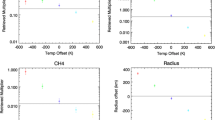Abstract
EChO is a dedicated mission to investigate exoplanetary atmospheres. When extracting the planetary signal, one has to take care of the variability of the hosting star, which introduces spectral distortion that can be mistaken as planetary signal. Magneticvariability has to be taken into account in particular for M stars. To this purpose, assuming a one spot dominant model for the stellar photosphere, we develop a mixed observational-theoretical tool to extract the spot’s parameters from the observed optical spectrum. This method relies on a robust library of spectral M templates, which we derive using the observed spectra of quiet M dwarfs in the SDSS database. Our procedure allows to correct the observed spectra for photospheric activity in most of the analyzed cases, reducing the spectral distortion down to the noise levels. Ongoing refinements of the template library and the algorithm will improve the efficiency of our algorithm.









Similar content being viewed by others
Notes
We are aware of the fact that our selection criterion likely leaves moderately active spectra in the subsamples. Moreover, recent studies indicate that the chromospheric H α emission line is not directly correlated with the level of chromospheric activity (see e.g. [5, 6, 8], for some recent studies of the H α diagnostic). Finally, we remark that we are assembling the subsample of photosphericallyquiet spectra based on a chromospheric indicator. For this reasons, the use of the H α indicator is questionnable. Nonetheless, the statistical approach we adopt in this section is robust with respect to spurious active spectra in our selection. All these points will be addressed in our forthcoming paper. For the purposes of this paper, we just need a gross selection of quiet spectra in order to promptly test our methodology, with the intention to improve our selection criterion as soon as the tests report positive results (as shown in Section 2).
References
Allard, F., Homeier, D., Freytag, B.: Model atmospheres from very low mass stars to brown Dwarfs. In: 16th Cambridge Workshop on Cool Stars, Stellar Systems, and the Sun, vol. 448, pp. 91 (2011)
Ballerini, P., Micela, G., Lanza, A. F., Pagano, I.: Multiwavelength flux variations induced by stellar magnetic activity: effects on planetary transits. Astron. Astrophys. 539, A140 (2012)
Berdyugina, S. V.: Starspots: A key to the Stellar dynamo. Living Rev. Solar Phys. 2, 8 (2005)
Bochanski, J. J., West, A. A., Hawley, S. L., Covey, K. R.: Low-mass Dwarf template spectra from the sloan digital sky survey. Astron. J. 133, 531 (2007)
Cincunegui, C., Díaz, R. F., Mauas, P. J. D.: H α and the Ca II H and K lines as activity proxies for late-type stars. Astron Astrophys. 469, 309 (2007)
Gomes da Silva, J., Santos, N. C., Bonfils, X., et al.: Long-term magnetic activity of a sample of M-dwarf stars from the HARPS program. I. Comparison of activity indices. Astron. Astrophys. 534, A30 (2011)
Jackson, R. J., Jeffries, R. D.: On the relationship between the size and surface coverage of starspots on magnetically active low-mass stars. Monthly Not. Royal Astron. Soc. 431, 1883 (2013)
Martínez-Arnáiz, R., López-Santiago, J., Crespo-Chacón, I., Montes, D.: Effect of magnetic activity saturation in chromospheric flux-flux relationships. Monthly Not. Royal Astron. Soc. 414, 2629 (2011)
Micela, G.: This Volume of Experimental Astronomy
Reid, I. N., Hawley, S. L.: New light on dark stars red Dwarfs, low-mass stars, brown stars. Praxis Publishing Ltd (2005)
Ribas, I.: This volume of experimental astronomy
Stelzer, B., Frasca, A., Alcalá, J. M., et al.: X-shooter spectroscopy of young stellar objects. III. Photospheric and chromospheric properties of class III objects. Astron. Astrophys. 558, A141 (2013)
Tinetti, G., Beaulieu, J. P., Henning, T., et al.: EChO. Exoplanet characterisation observatory. Exp. Astron. 34, 311 (2012)
Tinetti, G.: This volume of experimental astronomy
West, A. A., Morgan, D. P., Bochanski, J. J., et al.: The Sloan digital sky survey data release 7 spectroscopic M Dwarf catalog I. Data. Astron. J. 141, 97 (2011)
York, D. G., Adelman, J., Anderson, J. E. Jr, et al.: The sloan digital sky survey: Technical summary. Astron. J. 120, 1579 (2000)
Acknowledgments
The authors acknowledge fundings from the ASI-INAF agreement “Missione EChO: assessment phase” I/022/12/0.
The authors acknowledge A. Adriani for providing EChO’s transmissivity function.
The authors acknowledge publisher Springer. The final publication of this paper is available at link.springer.com.
Funding for SDSS-III has been provided by the Alfred P. Sloan Foundation, the Participating Institutions, the National Science Foundation, and the U.S. Department of Energy Office of Science. The SDSS-III web site is http://www.sdss3.org/.
SDSS-III is managed by the Astrophysical Research Consortium for the Participating Institutions of the SDSS-III Collaboration including the University of Arizona, the Brazilian Participation Group, Brookhaven National Laboratory, Carnegie Mellon University, University of Florida, the French Participation Group, the German Participation Group, Harvard University, the Instituto de Astrofisica de Canarias, the Michigan State/Notre Dame/JINA Participation Group, Johns Hopkins University, Lawrence Berkeley National Laboratory, Max Planck Institute for Astrophysics, Max Planck Institute for Extraterrestrial Physics, New Mexico State University, New York University, Ohio State University, Pennsylvania State University, University of Portsmouth, Princeton University, the Spanish Participation Group, University of Tokyo, University of Utah, Vanderbilt University, University of Virginia, University of Washington, and Yale University.
Author information
Authors and Affiliations
Corresponding author
Rights and permissions
About this article
Cite this article
Scandariato, G., Micela, G. EChO spectra and stellar activity II. The case of dM stars. Exp Astron 40, 711–722 (2015). https://doi.org/10.1007/s10686-014-9390-5
Received:
Accepted:
Published:
Issue Date:
DOI: https://doi.org/10.1007/s10686-014-9390-5




